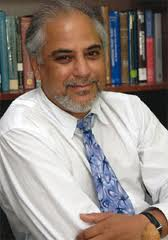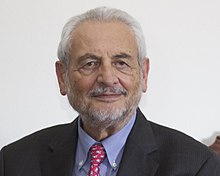
DESY, short for Deutsches Elektronen-Synchrotron, is a national research centre for fundamental science located in Hamburg and Zeuthen near Berlin in Germany. It operates particle accelerators used to investigate the structure, dynamics and function of matter, and conducts a broad spectrum of interdisciplinary scientific research in four main areas: particle and high energy physics; photon science; astroparticle physics; and the development, construction and operation of particle accelerators. Its name refers to its first project, an electron synchrotron. DESY is publicly financed by the Federal Republic of Germany and the Federal States of Hamburg and Brandenburg and is a member of the Helmholtz Association.

SLAC National Accelerator Laboratory, originally named the Stanford Linear Accelerator Center, is a federally funded research and development center in Menlo Park, California, United States. Founded in 1962, the laboratory is now sponsored by the United States Department of Energy and administrated by Stanford University. It is the site of the Stanford Linear Accelerator, a 3.2 kilometer (2-mile) linear accelerator constructed in 1966 that could accelerate electrons to energies of 50 GeV.

A free-electron laser (FEL) is a fourth generation light source producing extremely brilliant and short pulses of radiation. An FEL functions much as a laser but employs relativistic electrons as a gain medium instead of using stimulated emission from atomic or molecular excitations. In an FEL, a bunch of electrons passes through a magnetic structure called an undulator or wiggler to generate radiation, which re-interacts with the electrons to make them emit coherently, exponentially increasing its intensity.

Wolfgang Kurt Hermann "Pief" Panofsky, was a German-American physicist who won many awards including the National Medal of Science.
Plasma acceleration is a technique for accelerating charged particles, such as electrons or ions, using the electric field associated with electron plasma wave or other high-gradient plasma structures. These plasma acceleration structures are created using either ultra-short laser pulses or energetic particle beams that are matched to the plasma parameters. The technique offers a way to build affordable and compact particle accelerators.

Electron scattering occurs when electrons are displaced from their original trajectory. This is due to the electrostatic forces within matter interaction or, if an external magnetic field is present, the electron may be deflected by the Lorentz force. This scattering typically happens with solids such as metals, semiconductors and insulators; and is a limiting factor in integrated circuits and transistors.
Self-amplified spontaneous emission (SASE) is a process within a free-electron laser (FEL) by which a laser beam is created from a high-energy electron beam.
Joachim Stöhr is a physicist and professor emeritus of the Photon Science Department of Stanford University. His research has focused on the development of X-ray and synchrotron radiation techniques and their applications in different scientific fields with emphasis on surface science and magnetism. During his career he also held several scientific leadership positions, such as the director of the Stanford Synchrotron Radiation Laboratory (SSRL) and he was the founding director of the Linac Coherent Light Source (LCLS), the world's first x-ray free electron laser.

The European X-Ray Free-Electron Laser Facility is an X-ray research laser facility commissioned during 2017. The first laser pulses were produced in May 2017 and the facility started user operation in September 2017. The international project with twelve participating countries; nine shareholders at the time of commissioning, later joined by three other partners, is located in the German federal states of Hamburg and Schleswig-Holstein. A free-electron laser generates high-intensity electromagnetic radiation by accelerating electrons to relativistic speeds and directing them through special magnetic structures. The European XFEL is constructed such that the electrons produce X-ray light in synchronisation, resulting in high-intensity X-ray pulses with the properties of laser light and at intensities much brighter than those produced by conventional synchrotron light sources.
FLASH, acronym of Free Electron LASer in Hamburg, is a superconducting particle accelerator-based soft X-ray free-electron laser located at the German national laboratory DESY in Hamburg, Germany. It can generate very powerful, ultrashort pulses (~10−14 s) of coherent radiation in the energy range from 10 eV (electronvolt) to 300 eV. It started operation for external users in the year 2005 and is used for surface, molecular and atomic physics experiments. Intended applications are also the imaging of single biological complex molecules with time resolution.

Swapan Chattopadhyay CorrFRSE is an Indian American physicist. Chattopadhyay completed his PhD from the University of California (Berkeley) in 1982.

A particle accelerator is a machine that uses electromagnetic fields to propel charged particles to very high speeds and energies, and to contain them in well-defined beams.
An energy recovery linac (ERL) is a type of linear particle accelerator that provides a beam of electrons used to produce x-rays by synchrotron radiation. First proposed in 1965 the idea gained interest since the early 2000s.
The SPring-8 Angstrom Compact free electron LAser, referred to as SACLA, is an X-ray free-electron laser (XFEL) in Harima Science Garden City, Japan, embedded in the SPring-8 accelerator and synchrotron complex. When it first came into operation 2011, it was the second XFEL in the world and the first in Japan.
Toshiki Tajima is a Japanese theoretical plasma physicist known for pioneering the laser wakefield acceleration technique with John M. Dawson in 1979. The technique is used to accelerate particles in a plasma and was experimentally realized in 1994, for which Tajima received several awards such as the Nishina Memorial Prize (2006), the Enrico Fermi Prize (2015), the Robert R. Wilson Prize (2019), the Hannes Alfvén Prize (2019) and the Charles Hard Townes Award (2020).
Sandra Gail Biedron is an American physicist who serves as the Director of Knowledge Transfer for the Center for Bright Beams as well as professor in Electrical & Computer Engineering and Mechanical Engineering at the University of New Mexico, where in 2021 she mentors nine graduate students and two post-doctoral researchers. Her research includes developing, controlling, operating, and using laser and particle accelerator systems. She is also Chief Scientist of Element Aero, a consulting and R&D company incorporated in 2002. She was elected Fellow of the American Physical Society in 2013.
Alexander Wu Chao is a Taiwanese-American physicist, specializing in accelerator physics.
Sergio Carbajo is a Basque-Spanish-American scientist and educator, musician and composer, and creative writer. He is an assistant professor at the University of California, Los Angeles Samueli School of Engineering and Applied Sciences with appointments in the Electrical & Computer Engineering (ECE) and Physics & Astronomy departments. He is also a scientist at Stanford University’s Photon Science Division at SLAC National Accelerator Laboratory.

Ilan Ben-Zvi is an accelerator physicist and academic. He was the associate chair for accelerator R&D at the Collider-Accelerator Department (C-AD), and is a distinguished scientist emeritus at the Collider-Accelerator Department (C-AD) at Brookhaven National Laboratory.









